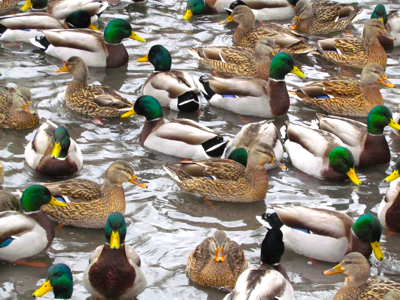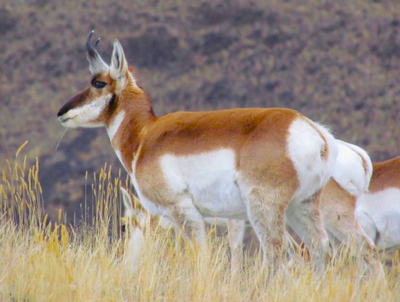For our tour description, itinerary, past triplists, dates, fees, and more, please VISIT OUR TOUR PAGE.
See this triplist in printable PDF format with media only on page 1.

The group enjoys an
invigorating stroll alongside one of Yellowstone's
magnificent thermal features, without the crowds of summer!
(Photo by guide Terry McEneaney)
Our 2012 Yellowstone In Winter tour met expectations and in some cases exceeded expectations. First of all the winter conditions were perfect. Since everyone was well prepared and dressed for the occasion, no one felt cold on this adventure, and a "Yellowstone In Winter" adventure it was! We set Field Guides "Yellowstone In Winter" numerical wildlife records for Gyrfalcon, Bohemian Waxwing, Common Redpoll and Townsend's Solitaire, but our greatest experience of all was finding 30 Gray Wolves! We watched wolf territorial interactions as the Mollie's pack (19 individuals) came into contact with the Lamar Valley pack (11 individuals). Our most memorable sighting was the pack of 19 individual wolves traveling a snow-corniced ridge, following each other's footsteps to save energy in the deep snow. It was a classic "Yellowstone in Winter" Field Guides experience.
Thanks for joining us on this winter adventure, and we look forward to seeing you on another tour someday soon.
-Terry & Karen
KEYS FOR THIS LIST
One of the following keys may be shown in brackets for
individual species as appropriate: * = heard only, I =
introduced, E = endemic, N = nesting, a = austral migrant, b =
boreal migrant
BIRDS

A small sampling
of the 1000+ Mallards seen on the tour. The males are
truly stunning in their fresh breeding plumage.(Photo by
guide Terry McEneaney)

Though often
referred to as an antelope, the Pronghorn is in a family
all its own, and seems to be most closely related to the
giraffes! (Photo by guide Terry McEneaney)
MAMMALS
ADDITIONAL COMMENTS
The FG Yellowstone in Winter tour went very well. Although winter was slow in coming we made up for it with cold temperatures and by experiencing 2 ground blizzards. Thank goodness. It was a real Yellowstone in Winter experience for the entire trip. We had sun the first, second, and last couple days. Although we did not experience the snow events of last year, our experience was equally grand. Everyone appeared to have a wonderful time, and greeted the blizzard as a unique experience of a lifetime.
We ended up with approximately 52 species of birds and 10 species of mammals-not bad considering the blizzards and stormy skies. Numerical bird highlights of the trip included: one rare Gyrfalcon to start off the trip, over 3-4,000 Bohemian Waxwings to end the trip, 100+ Cedar Waxwing, 150+Common Redpoll, over 1,300 Gray-crowned Rosy-Finches (including Hepburn race), 60 Townsend’s Solitaire, 60 Golden Eagle, 50 Bald Eagles, 60 Rough-legged Hawk, 40 American Dipper, and 2 Prairie Falcon. For mammals the numerical highlights were equally impressive: over 1300 elk, over 800 white-tailed deer, over 400 mule deer, over 1300 bison, approximately 150 bighorn sheep, 200 pronghorn, 2 muskrat, 20 coyotes, and a whopping total of 30 wolves (a FG Yellowstone In Winter tour record).
But the wildlife interactions and inter-relationships of various prey and predators in a winter environment really made this a great memorable trip. Thanks for allowing us the opportunity to show you Yellowstone In Winter. It has been a pleasurable experience. Take good care! And we hope to see you again!
Terry and Karen McEneaney
Totals for the tour: 52 bird taxa and 10 mammal taxa
